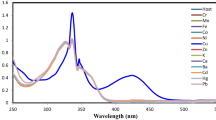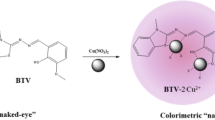Abstract
In this study, a simple Benzimidazole based bifunctional chemosensor 4-(2-(3,4-dimethoxyphenyl)-1H-benzo[d]imidazol-6-yl) benzene-1,2-diamine, L was synthesized and characterized. The sensor proved to be selective and sensitive towards detecting banned azo dyes Sudan Dye I, II, and Metanil Yellow via fluorescence turn-off response. The proposed mechanism of fluorescence quenching was the inner filter effect. LODs for Sudan I, II, and Metanil Yellow were found to be 0.009 µM, 0.012 µM, and 0.0073 µM, respectively. The developed chemosensor also showed a colorimetric response towards Cu (II) ions via an apparent color change from yellow to pink. LOD for Cu (II) ions was found to be 1.2 µM. The synthesized benzimidazole based bifunctional chemosensor was adequately tested to determine Sudan I in Red chili powder and red Food color samples, Metanil yellow in turmeric powder, and Cu(II) packaged coconut water.






Similar content being viewed by others
Data Availability
All data generated or analysed during this study are included in this published article ( and its supplementary information files) The datasets generated during and/or analysed during the current study are available from the corresponding author on reasonable request.
References
Moreno-González D, Jáč P, Švec F, Nováková L (2020) Determination of Sudan dyes in chili products by micellar electrokinetic chromatography-MS/MS using a volatile surfactant. Food Chem 310:125963. https://doi.org/10.1016/j.foodchem.2019.125963
Wu C, Lu Q, Miu X et al (2018) A simple assay platform for sensitive detection of Sudan I-IV in chilli powder based on CsPbBr 3 quantum dots. J Food Sci Technol 55:2497–2503. https://doi.org/10.1007/s13197-018-3167-1
Wu M, Sun L, Miao K et al (2018) Detection of Sudan Dyes Based on Inner-Filter Effect with Reusable Conjugated Polymer Fibrous Membranes. ACS Appl Mater Interfaces 10:8287–8295. https://doi.org/10.1021/acsami.8b00164
Li Y, Yang Y, Yin S et al (2018) Inedible azo dyes and their analytical methods in foodstuffs and beverages. J AOAC Int 101:1314–1327. https://doi.org/10.5740/jaoacint.18-0048
Dhakal S, Chao K, Schmidt W et al (2016) Evaluation of Turmeric Powder Adulterated with Metanil Yellow Using FT-Raman and FT-IR Spectroscopy. Foods 5:36. https://doi.org/10.3390/foods5020036
Fernandes C, Rao KV (1994) Dose related promoter effect of metanil yellow on the development of hepatic pre-neoplastic lesions induced by N-nitrosodiethylamine in rats. Indian J Med Res 100:140–149
Raza H, Khanna SK, Singh GB (1978) Metanil yellow & gastric mucin. Indian J Exp Biol 16:383–384
Prasad OM, Rastogi PB (1983) Haematological changes induced by feeding a common food colour, metanil yellow, in albino mice. Toxicol Lett 16:103–107. https://doi.org/10.1016/0378-4274(83)90017-6
Bonan S, Fedrizzi G, Menotta S, Elisabetta C (2013) Simultaneous determination of synthetic dyes in foodstuffs and beverages by high-performance liquid chromatography coupled with diode-array detector. Dye Pigment 99:36–40. https://doi.org/10.1016/j.dyepig.2013.03.029
Dixit S, Purshottam SK, Khanna SK, Das M (2009) Surveillance of the quality of turmeric powders from city markets of India on the basis of curcumin content and the presence of extraneous colours. Food Addit Contam - Part A Chem Anal Control Expo Risk Assess 26:1227–1231. https://doi.org/10.1080/02652030903016586
Fukuji TS, Castro-Puyana M, Tavares MFM, Cifuentes A (2011) Fast determination of Sudan dyes in chilli tomato sauces using partial filling micellar electrokinetic chromatography. J Agric Food Chem 59:11903–11909. https://doi.org/10.1021/jf203201b
Wu M, Li P, Zhu Q et al (2018) Functional paper-based SERS substrate for rapid and sensitive detection of Sudan dyes in herbal medicine. Spectrochim Acta - Part A Mol Biomol Spectrosc 196:110–116. https://doi.org/10.1016/j.saa.2018.02.014
Petrakis EA, Cagliani LR, Tarantilis PA et al (2017) Sudan dyes in adulterated saffron (Crocus sativus L.): Identification and quantification by 1H NMR. Food Chem 217:418–424. https://doi.org/10.1016/j.foodchem.2016.08.078
Di Anibal CV, Callao MP, Ruisánchez I (2011) 1H NMR and UV-visible data fusion for determining Sudan dyes in culinary spices. Talanta 84:829–833. https://doi.org/10.1016/j.talanta.2011.02.014
Wang J, Wei K, Li H et al (2012) A sensitive and selective enzyme-linked immunosorbent assay for the analysis of para red in foods. Analyst 137:2136–2142. https://doi.org/10.1039/C2AN35127G
Liu Z, Zhi A, Zhao L et al (2014) Development of an ELISA for detection of Sudan I in food samples using monoclonal antibody. Food Agric Immunol 25:556–568. https://doi.org/10.1080/09540105.2013.858309
Fang A, Long Q, Wu Q et al (2016) Upconversion nanosensor for sensitive fluorescence detection of Sudan I-IV based on inner filter effect. Talanta 148:129–134. https://doi.org/10.1016/j.talanta.2015.10.048
Ling Y, Li JX, Qu F et al (2014) Rapid fluorescence assay for Sudan dyes using polyethyleneimine-coated copper nanoclusters. Microchim Acta 181:1069–1075. https://doi.org/10.1007/s00604-014-1214-9
S Dhakal K Chao W Schmidt et al (2018) Detection of azo dyes in curry powder using a 1064-nm dispersive point-scan Raman system. Appl Sci 8. https://doi.org/10.3390/app8040564
Chen H, Chen M, Wang X, Sun R (2014) Self-assembled conjugated polymer/carboxymethyl chitosan grafted poly(p-dioxanone) nanomicelles and their use in functionalized indicator paper for fast and visual detection of a banned food dye. Polym Chem 5:4251–4258. https://doi.org/10.1039/c4py00120f
Mahnashi MH, Mahmoud AM, Alkahtani SA et al (2020) A novel imidazole derived colorimetric and fluorometric chemosensor for bifunctional detection of copper (II) and sulphide ions in environmental water samples. Spectrochim Acta Part A Mol Biomol Spectrosc 228:117846. https://doi.org/10.1016/j.saa.2019.117846
Narayanaswamy N, Govindaraju T (2012) Aldazine-based colorimetric sensors for Cu2+ and Fe3+. Sensors Actuators B Chem 161:304–310. https://doi.org/10.1016/j.snb.2011.10.036
Vyas G, Bhatt S, Si MK et al (2020) Colorimetric dual sensor for Cu(II) and tyrosine and its application as paper strips for detection in water and human saliva as real samples. Spectrochim Acta Part A Mol Biomol Spectrosc 230:118052. https://doi.org/10.1016/j.saa.2020.118052
Wang N, Liu Y, Li Y et al (2018) Fluorescent and colorimetric sensor for Cu2+ ion based on formaldehyde modified hyperbranched polyethylenimine capped gold nanoparticles. Sensors Actuators B Chem 255:78–86. https://doi.org/10.1016/j.snb.2017.08.035
Reis BF, Knochen M, Pignalosa G et al (2004) A multicommuted flow system for the determination of copper, chromium, iron and lead in lubricating oils with detection by flame AAS. Talanta 64:1220–1225. https://doi.org/10.1016/j.talanta.2004.03.070
Camino M, Bagur MG, Sánchez-Viñas M et al (2001) Multivariate optimization of solvent extraction of Cd(ii){,} Co(ii){,} Cr(vi){,} Cu(ii){,} Ni(ii){,} Pb(ii) and Zn(ii) as dibenzyldithiocarbamates and detection by AAS. J Anal At Spectrom 16:638–642. https://doi.org/10.1039/B101590G
Ghisi M, Chaves ES, Quadros DPC et al (2011) Simple method for the determination of Cu and Fe by electrothermal atomic absorption spectrometry in biodiesel treated with tetramethylammonium hydroxide. Microchem J 98:62–65. https://doi.org/10.1016/j.microc.2010.11.003
Pomazal K, Prohaska C, Steffan I et al (1999) Determination of Cu{,} Fe{,} Mn{,} and Zn in blood fractions by SEC-HPLC-ICP-AES coupling. Analyst 124:657–663. https://doi.org/10.1039/A809688K
Zhang N, Qu F, Luo HQ, Li NB (2013) Sensitive signal-on fluorescent sensing for copper ions based on the polyethyleneimine-capped silver nanoclusters–cysteine system. Anal Chim Acta 791:46–50. https://doi.org/10.1016/j.aca.2013.06.045
Li F, Wang J, Lai Y et al (2013) Ultrasensitive and selective detection of copper (II) and mercury (II) ions by dye-coded silver nanoparticle-based SERS probes. Biosens Bioelectron 39:82–87. https://doi.org/10.1016/j.bios.2012.06.050
Tsoutsi D, Guerrini L, Hermida-Ramon JM et al (2013) Simultaneous SERS detection of copper and cobalt at ultratrace levels. Nanoscale 5:5841–5846. https://doi.org/10.1039/C3NR01518A
Chen Y, Lian Y, Huang M et al (2019) A dual-mode fluorometric/colorimetric sensor for Cu2+ detection based on hybridized carbon dots and gold–silver core–shell nanoparticles. Analyst 144:4250–4257. https://doi.org/10.1039/C9AN00850K
Udhayakumari D, Naha S, Velmathi S (2017) Colorimetric and fluorescent chemosensors for Cu2+. A comprehensive review from the years 2013–15. Anal Methods 9:552–578. https://doi.org/10.1039/C6AY02416E
Pei-Pei Jia S-TJ, LX, (2019) Small-molecule Bifunctional Fluorescent Probes for the Differential Detection of Multiple Guests. Curr Org Synth 16:485–497. https://doi.org/10.2174/1570179416666190419213812
Wu YC, Jiang K, Luo SH et al (2019) Novel dual-functional fluorescent sensors based on bis(5,6-dimethylbenzimidazole) derivatives for distinguishing of Ag+ and Fe3+ in semi-aqueous medium. Spectrochim Acta Part A Mol Biomol Spectrosc 206:632–641. https://doi.org/10.1016/j.saa.2018.05.069
Acknowledgements
The authors would like to acknowledge the Chairman, Department of chemistry, Aligarh Muslim University, Aligarh, India, for providing necessary research facilities given to the department under SAP-DRS-II PURSE, and FIST programs are highly acknowledged. The authors would also like to acknowledge SAIF IIT Madras and SAIF Panjab University for providing NMR, Mass, and elemental analysis facilities.
Funding
No funding was received for conducting this study.
Author information
Authors and Affiliations
Contributions
Conceptualization: [Ambreen Abbasi]; Methodology: [Ambreen Abbasi]; Formal analysis and investigation: [Ambreen Abbasi, Ifra Ilyas Ansari]; Writing—original draft preparation: [Ambreen Abbasi];
Writing—review and editing: [Ambreen Abbasi], Supervision: [Mohammad Shakir].
Corresponding author
Ethics declarations
Conflicts of Interest
Authors have no conflicts of interest to declare that are relevant to content of this article.
Additional information
Publisher's Note
Springer Nature remains neutral with regard to jurisdictional claims in published maps and institutional affiliations.
Supplementary Information
Below is the link to the electronic supplementary material.
Rights and permissions
About this article
Cite this article
Abbasi, A., Ansari, I.I. & Shakir, M. Highly Selective and Sensitive Benzimidazole Based Bifunctional Sensor for Targeting Inedible Azo Dyes in Red Chilli, Red Food Color, Turmeric Powder, and Cu(Ii) in Coconut Water. J Fluoresc 31, 1353–1361 (2021). https://doi.org/10.1007/s10895-021-02766-5
Received:
Accepted:
Published:
Issue Date:
DOI: https://doi.org/10.1007/s10895-021-02766-5




